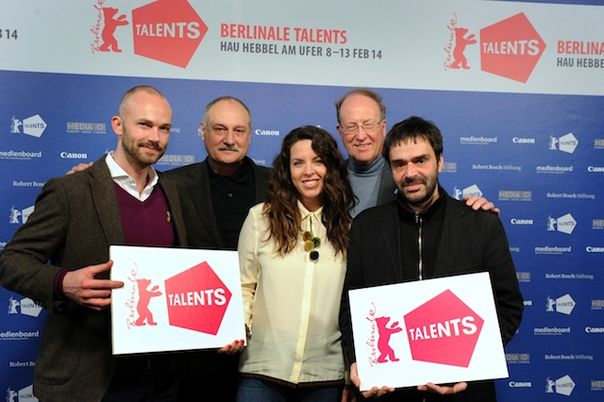Creating Characters
Dasha Lisitsina of the 2014 Talent Press reports from the panel discussion Women on the Verge of a Nervous Breakdown: Successful Screenwriting at Berlinale Talents.

Matthijs Wouter Knol, Tony Grisoni, Claudia Llosa, Peter Cowie and Răzvan Rădulescu
In the bubbly panel discussion “Women on the Verge of a Nervous Breakdown: Successful Screenwriting“, renowned screenwriters Claudia Llosa from Peru (ALOFT, THE MILK OF SORROW), Răzvan Rădulescu from Romania (CHILD'S POSE, FIRST OF ALL FELICIA) and Tony Grisoni from the UK (FEAR AND LOATHING IN LAS VEGAS) discussed their different approaches to working. Popular thinking has it that writers are much better at doing their work than speaking about it. But these three screenwriters talked about their approach to creating characters with charming honesty and humour.
Llosa's THE MILK OF SORROW, Rădulescu's CHILD'S POSE and Grisoni's forthcoming British TV mini-series SOUTHCLIFFE – the three works under discussion – all examine the volatile nature of mother-child relationships. THE MILK OF SORROW takes its title from the Peruvian folklore notion that suffering is passed on generationally through a mother's milk. Rădulescu's film is part of his continuous exploration of generational conflict and strong middle-aged female characters. SOUTHCLIFFE, set in a nondescript English market town, charts the gradual breakdown of social worker and mother Clare.
The respective screenwriters have radically different ways of writing characters. Llosa explained that she was aware of using non-professional actors in THE MILK OF SORROW and therefore kept the script sparse, predominantly using strong images to tell the story. According to her, the framing of fragmented bodies acts as a visual metaphor for the mutilation in and of Peruvian history, and the silence of the film – the reluctance to speak about the traumatic cultural past. Llosa claims to use evocative singing as a cathartic release that replaces and supersedes dialogue.
Rădulescu's signature script style is dialogue heavy; his ear for the nuances and comedy of everyday banal conversation is marked. In response to suggestions that his reliance on dialogue is perhaps not in the cinematic vein of storytelling, Rădulescu uses Eric Rohmer's defence that film is not just another form of literature or theatre just because it has dialogue in it. However, unlike Rohmer's theatrical speech, Rădulescu's conversational dialogue comes across as authentic even to a non-Romanian ear.
British Tony Grisoni works very closely with directors both during the scriptwriting and filming process, so that he can alter or re-write scenes according to how the shoot naturally progresses. His continuous re-working of the now 13-year old Terry Gilliam project “Don Quixote“ is a running joke in the film industry. But Llosa applauds the fluidity of Grisoni's collaborative approach, revealing how useful she finds it to have a screenwriter on board during shoots. The one thing all three screenwriters agreed on is that during the writing process their characters become people to them. Their aim is that the same thing happens for the audience

